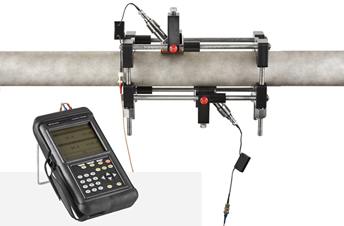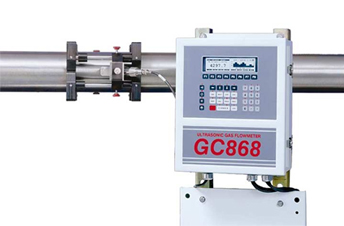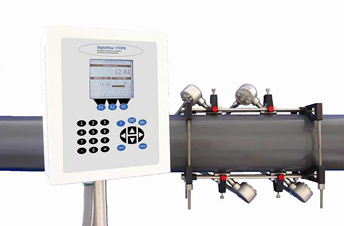Understanding Clamp-on Gas: Conditions Required for Measuring Gas Flow with Ultrasonic Technology
Industry Sector
Process Gas, Production, Commercial Gas, Public Sector
Clamp-on ultrasonic flowmeter systems are effective when fluid or gas flows need to be measured without cutting into and modifying pipework. Many fluids and pipe materials are acoustically conductive, in that they can absorb and transmit ultrasound. This ability to transmit sound waves means that ultrasound can be used to measure flow rates with sensors mounted on the external pipe wall, using a principle known as transit time differential (the difference in transit times as the sound wave travels to and from the pipe walls).
Gas flows can be measured using ultrasonic transit time differential methods, however there are considerations to take into account.



#1 – Specific gas that is being measured:
Different gases with different properties are more straight-forward to measure than other gases. Mixed gases can pose some difficulties, as ultrasonic transit-time technology is best suited to singular fluid or singular gas compositions. The simplest gases to measure using clamp-on ultrasonic technology is compressed air and nitrogen. Hydrocarbon gases are more difficult, as their properties lead to attenuation (greater attenuation leads to the ultrasound signal becoming ‘scattered’).
#2 – Resonance, influenced by pipe wall material and gas pressure:
Another factor that impacts about the performance of clamp-on gas is the resonance noise created by the metal pipe wall. Resonance is vibrational noise and is present when the pipe wall is metal (such as carbon steel for example) and the gas pressure is low (under 5 bar). Under these conditions, the ultrasound signal emitted by the clamp-on flowmeter’s sensors will become lost due to the resonance noise cancelling out the ultrasonic signal. Therefore, clamp-on flowmeter systems require a minimum pressure for the signal to be clear enough to measure the differential in transit time. There is no resonance in plastic, thus pressure and loss of signal is less of an issue in this case.
#3 – Availability of straight run pipe:
Many flowmeter technologies need straight run pipe available upstream and downstream from the point of measurement. The same is true for ultrasonic transit time differential flowmeter systems. A system measuring fluid flow needs 10x the diameter upstream from the point of measurement, and 5x downstream, to be able to measure the flow at the highest level of measurement accuracy. For gas flow measurement, even more straight run pipe without bends and valves is required: 20x the diameter upstream from the point of measurement, and 10x diameter downstream. This is due to gas having less density than fluid, leading to more space being required for the flow profile to form fully following a bend or a valve in the process pipe.
#4 – Other considerations:
There are other aspects that can determine the outcome of clamp-on flow measurement using ultrasonic transit time differential technology. Regardless of fluid or gas measurement, the condition of the pipe is a factor, the less corrosion and the better the insulation from external noise, the lower the risk of attenuation and the signal being scattered. The usual aspects of clamp-on flowmeter system programming and set-up apply. In short, the pipe diameter, wall thickness, transducer spacing, and temperature data input needs to be correct.
Trial-service:
RS Hydro's engineering team have successfully installed gas clamp-on flowmeters and provide services such as hire-installation and verification of gas flowmeters. Clamp-on gas flow measurement can be challenging, especially if it is the first time for the user of the system. Therefore, it is possible to test the technology on the application first, before deciding upon which technology to use. For more information on this service, feel free to reach out to RS Hydro's sales team for more information.
